Hoops and Frames
Whilst not essential, hoops and frames are beneficial for all types of stitching where the fabric needs to be kept taut. They provide better tension than if the fabric is hand-held, and help to prevent distortion, especially in linen and evenweave fabrics which are softer than aida. Keeping the fabric under tension also helps give the finished piece a more even appearance and reduces the amount the fabric is handled. Some can also accommodate magnifiers, lights and special clips for securing a chart.
Personal preference will dictate your choice, as will the size of the project. Detailed below is some additional information that you might find useful. It does not cover every option available but hopefully provides a good overview.
HOOPS
Often used for smaller items, hoops are lightweight, portable, and for some designs are used to frame the final piece. Some can also be held on stands.
They come in a large variety of sizes and it is important to consider the design size when choosing. In holding the fabric taut they do tend to crease the material and, if the design is larger than the hoop, moving it around the fabric as you work can lead to stitched sections becoming squashed. One option is to remove the hoop in-between stitching sessions, but it is preferable to choose a hoop large enough to accommodate the entire design.
Whilst it needs to be large enough, it mustn’t be too big, as it will then be difficult to keep the fabric taut – so you can see as far as hoops are concerned…size really is important!
There are three main types of hoop;
Wooden Hoops
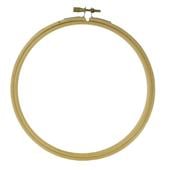 Available in many sizes the hoop is constructed of two rings, one fitting inside the other, and with the outer ring having a screw for tightening.
Available in many sizes the hoop is constructed of two rings, one fitting inside the other, and with the outer ring having a screw for tightening.
To secure your work open up the hoop and position the inner ring under the fabric (make sure the fabric is central and the right side is facing up) than place the outer ring over the top of the fabric, pushing it down over the inner. Tighten the screw to secure the fabric firmly.
Spring Tension Hoops

Similar design to wooden hoops except the inner ring is a sprung metal hoop and the outer is plastic.
To secure your work place the outer plastic ring under the fabric (make sure the fabric is central and the right side is facing down) than squeeze the clips of the metal inner ring and place over the top of the fabric, pushing it down over the outer. Release the clips to secure the fabric.
Flexi Hoops
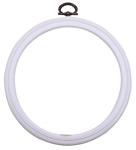
Often used for small projects as they do not have such a strong grip on the fabric. Similar to the wooden hoops except the inner ring is solid plastic and the outer ring is a more rubbery plastic.
The fabric is secured in the same way as for the wooden hoops but as there is no screw the outer ring simply fits snugly over the inner. Available in a wide range of colours they are often used as the final frame for the finished piece.
FRAMES
Frames are often used for larger projects and come in a variety of sizes, some with stands and other accessories. As with hoops, size is important but frames tend to be more accommodating of a wider size range, and generally less likely to crease the fabric.
There are two main types;
Roller Frames
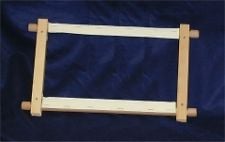
These frames have a tape strip on two rollers to which you sew the edges of your fabric. Mark the centre of your fabric before attaching and then roll the fabric evenly from the top and/or bottom as needed, re-rolling when necessary to move the fabric to a new stitching area.
If held on a frame, take care to pad the rolled fabric where the frame will grip the roller as this will help to prevent a mark on the fabric.
Easy Clip Frames
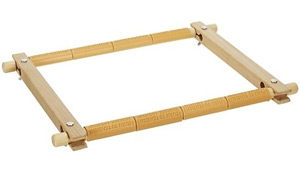
They work on the same principle as the roller frame but instead of sewing the fabric to the rollers it is held on place with clips.
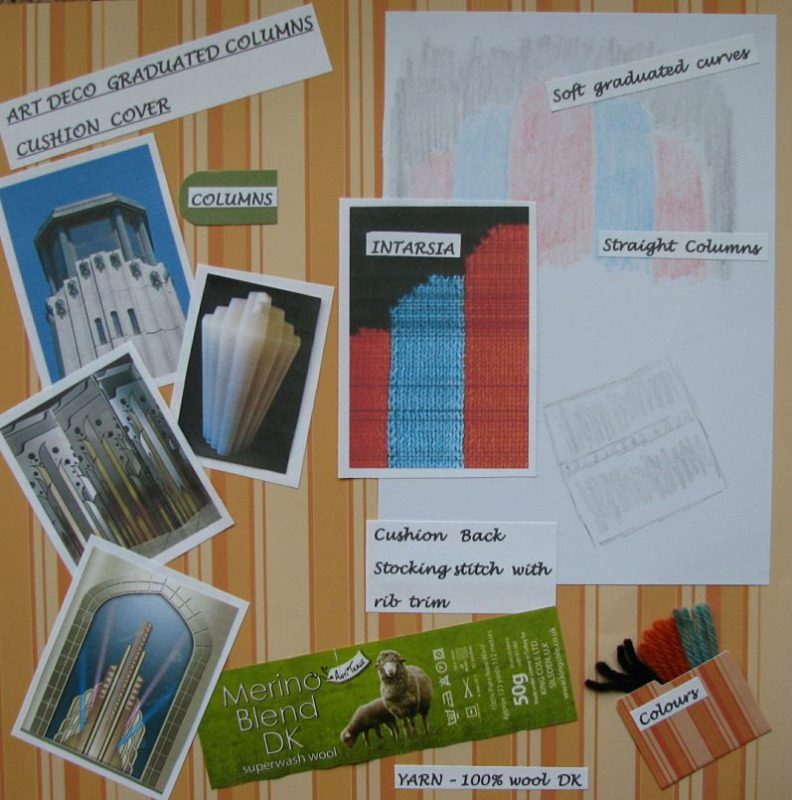

 Available in many sizes the hoop is constructed of two rings, one fitting inside the other, and with the outer ring having a screw for tightening.
Available in many sizes the hoop is constructed of two rings, one fitting inside the other, and with the outer ring having a screw for tightening. 



